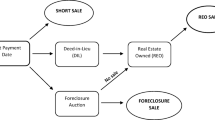Abstract
When mortgage borrowers default and have no desire or ability to keep their property, then loss mitigation involves a sale of the property via one of the following options: (1) the lender allows pre-foreclosure “short sale” by the borrower, (2) the lender institutes the foreclosure process under a notice of default and the property is sold during the process by the borrower, and (3) the lender forecloses on the property, takes title, and sells the property in the market as real estate owned (REO). Sale of the property in the above three options is conducted by a motivated seller, either the owner or the lender, who desires to sell the property as quickly as possible. Thus, relative to a no-default sale, the house is most likely to be sold at a discounted price. It is generally expected that the discount would be lower in the case of a “short sale.” This option, however, may result in a longer marketing time, thus a higher total loss, than the other two options. We developed a model that allows simultaneous estimation of price and time-on-market effects of “short sales,” foreclosures, and REO options. We find that the short-sale option has the lowest-price discount, but significantly higher costs associated with marketing time. The pattern of price discount and marketing time reverses as we move to a sale while in the process of foreclosure and to a sale with an REO status.
Similar content being viewed by others
Notes
When a borrower is delinquent he or she is said to have “defaulted” on the loan. The term default applies to a breach of any of the terms of the promissory note.
In previous studies it is often not clear whether the “foreclosure” status referred to a sale in the process of foreclosure a sale as REO, or both. REO is sometimes referred to as “bank owned.”
Ruthless default occurs immediately when the value of the property falls below the value of the mortgage. The value of the mortgage is not the same as the mortgage balance. The former is determined partially with respect to market interest rates and the rate on the mortgage. Because of transactions costs and the fact that the put option may be more valuable if unexercised, few borrowers are expected to exercise the put option ruthlessly.
In the first two types of sale the title will be in the name of the mortgagor. Only in the REO case will the title vest with the lender.
The search theory predicts a positive price-TOM relationship. Previous empirical studies, however, have found a negative relationship. This negative relationship has been attributed to a "stigma" effect of prolonged TOM (Jud et al. 1996). Taylor (1999) develops a theoretical model in which potential buyers use TOM as a signal, suspecting that the house is either overpriced or has a possible flaw that was discovered by previous prospective buyers. This gives rise to a potential buyer-herding situation and a reduced asking price over time. A very plausible explanation of the negative relationship is offered by Huang and Palmquist (2001). In investigating highway-noise effect on price and TOM, they found that market duration has a significant negative impact on the sale price. They concluded that as the TOM increases, sellers adjust their reservation price, resulting in an observed negative price-TOM relationship.
The neighborhood variables for more than 60 zip code areas come from the data that are collected and analyzed by the Center for Business and Economic Research at the University of Nevada, Las Vegas.
The total commission rate that is a part of the listing contract is not provided by the sources of our sample, the Greater Association of Realtors Las Vegas (GLVAR).
The GLVAR was not able to provide information on the year a broker joined the organization. Broker members, however, are given an identification number when they join the GLVAR. The ID number is assigned chronologically as members join. Given the limitations of this variable we are of the opinion that some information is better than none. Thus, using the assigned identification numbers, we can proxy the extent of the agent's experience in the Las Vegas real estate market. And, of course, some brokers could have easily had some experience previous to joining the GLVAR.
We do not have information about the length of time from initial default to the time the property is listed with MLS and the associated carrying cost. The lender most likely burdens carrying cost, such as lost interest, property taxes, hazard insurance, legal expenses, and maintenance and miscellaneous expenses associated with foreclosed and repossessed properties. It is also likely that in case of a short sale the borrower incurs the carrying costs up to time the property is placed on the market. Thereafter, the borrower, while occupying the property, has no incentive to continue paying the carrying costs and, therefore, will be incurred by the lender.
In the dataset, there are 277 homes sales that have indicators for both short sale and foreclosure. We included these observations in the short-sale subsample of 2,033. In the empirical section, however, we investigate whether these homes were sold with a foreclosed status after the failure of a short-sale option or they were sold as short sale during foreclosure process.
The negative marginal effect of number of bedrooms is also expected and consistent with the finding in the previous literature. Holding other physical characteristics, such as square feet of living area constant, consumers prefer a few large rooms rather than several small rooms.
Given that the dependent variable, price, is measured in natural logarithm, the precise percentage effect of the lake view variable on price is calculated as \( Ex{p^{\left( {\beta of lakeview} \right)}} - 1 = Ex{p^{\left( {0.2966} \right)}} - 1 = 34.5\% . \)
See Eggers F. J. and Fouad Moumen, (June 2008), “Trends in Housing Costs: 1987−2005 and the 30-Percent-of-Income Standard,” U.S. Department of Housing and Urban Development, Office of Policy Development and Research, at WWW.huduser.org.
Such as, the government takeover of Fannie Mae and Freddie Mac.
References
Ambrose, B. W., & Capone, C. A. (1996). Cost-benefit analysis of single-family foreclosure alternatives. Journal of Real Estate Finance and Economics, 13, 105–120.
Ambrose, B. W., & Capone, C. A. (2001). Optimal put exercise: an empirical examination of conditions for mortgage foreclosure. Journal of Real Estate Finance and Economics, 23, 213–34.
Avery, R. B., Bostic, R. W., Calem, P. S. & Canner, G. B. (1996). Credit risk, credit scoring, and the performance of home mortgages. Federal Reserve Bulletin, 621648.
Carroll, T. M., Clauretie, T. M., & Neill, H. (1997). Effect of foreclosure status on residential selling price: comment. Journal of Real Estate Research, 13(1), 95–102.
Clauretie, T. M., & Daneshvary, N. (2009). Estimating the house foreclosure discount corrected for spatial price interdependence and endogeniety of marketing time. Real Estate Economics, 37, 43–57.
Clauretie, T. M., & Thistle, P. (2007). The effect of time-on-market and location on search costs and anchoring: the case of single family properties. The Journal of Real Estate Finance and Economics, 35, 181–196.
Eggers, F. J., & Moumen, F. (2008). Trends in housing costs: 1985–2005 and the 30-percent-of-income standard. U.S. Department of Housing and Urban Development, Office of Policy Development and Research, at www.huduser.org.
Epperson, J. F., Kau, J. B., Keenan, D. C., & Muller, W. J., III. (1985). Pricing default risk in mortgages. AREUEA Journal, 13(3), 261–272.
Forgey, F. A., Rutherford, R. C., & VanBuskirk, M. L. (1994). Effect of foreclosure status on residential selling price. Journal of Real Estate Research, 9(3), 313–318.
Foster, C., & Van Order, R. (1984). An option-based model of mortgage default. Housing Finance Review, 3, 351–372.
Foster, C., & Van Order, R. (1985). FHA terminations: a prelude to rational mortgage pricing. AREUEA Journal, 13(3), 273–291.
Greene, W. H. (2003). Econometric Analysis. Upper Saddle River, New Jersey: Prentice Hall.
Hardin, W. G., & Wolverton, M. L. (1996). The relationship between foreclosure status and apartment price. Journal of Real Estate Research, 12(1), 101–109.
Harding, J. P., Knight, J. R., & Sirmans, C. F. (2003). Estimating bargaining effects in hedonic models: evidence from the housing market. Real Estate Economics, 31, 601–622.
Huang, J. C., & Palmquist, R. B. (2001). Environmental conditions, reservation prices, and time on the market for housing. The Journal of Real Estate Finance and Economics, 22, 203–219.
Jacoby, M. B. (2008). Home ownership risk beyond a subprime crisis: the role of delinquency management. Fordham Law Review, 76, 2261–2295.
Jud, G. D., Seaks, T. G., & Winkler, D. T. (1996). Time-on-the-market: the impact of residential brokerage. Journal of Real Estate Research, 12, 447–458.
Kau, J. B., Keenan, D. C., Muller, W. J., III, & Epperson, J. F. (1992). A generalized valuation model for fixed rate residential mortgages. Journal of Money, Credit and Banking, 24(3), 279–99.
Knight, J. R. (2002). Listing price, time on market, and ultimate selling price: causes and effects of listing price changes. Real Estate Economics, 30, 213–237.
Pennington-Cross, A. (2006). The value of foreclosed property. Journal of Real Estate Research, 28(2), 193–214.
Shilling, J. D., Benjamin, J. D., & Sirmans, C. F. (1990). Estimating net realizable value for distressed real estate. Journal of Real Estate Researc, 5(1), 129–139.
Sirmans, C. F., Turnbull, G. K., & Benjamin, J. D. (1991). The markets for housing and real estate broker services. Journal of Housing Economics, 1, 207–217.
Springer, T. M. (1996). Single family housing transactions: seller motivations, price, and marketing time. Journal of Real Estate Finance and Economics, 13(3), 237–54.
Taylor, C. R. (1999). Time-on-market as a sign of quality. Review of Economic Studies, 66, 555–578.
Yang, S. X., & Yavas, A. (1995). Bigger is not better: brokerage and time-on-the-market. Journal of Real Estate Research, 10, 23–34.
Yavas, A., & Yang, S. X. (1995). The strategic role of listing price in marketing real estate: theory and evidence. Real Estate Economics, 23, 347–368.
Author information
Authors and Affiliations
Corresponding author
Rights and permissions
About this article
Cite this article
Clauretie, T.M., Daneshvary, N. The Optimal Choice for Lenders Facing Defaults: Short Sale, Foreclose, or REO. J Real Estate Finan Econ 42, 504–521 (2011). https://doi.org/10.1007/s11146-009-9201-3
Published:
Issue Date:
DOI: https://doi.org/10.1007/s11146-009-9201-3



